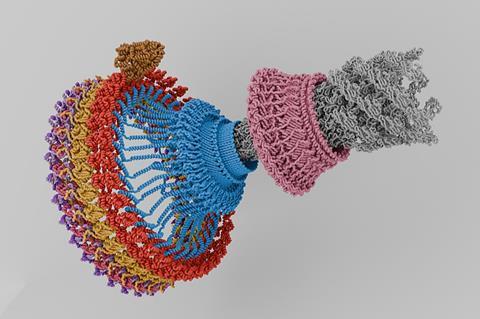When speaking of motors, most people think of those powering vehicles and human machinery. However, biological motors have existed for millions of years in microorganisms. Among these, many bacterial species have tail-like structures—called flagella—that spin around to propel themselves in fluids. These movements employ protein complexes known as the “flagellar motor”.

This flagellar motor consists of two main components: the rotor and the stators. The rotor is a large rotating structure, anchored to the cell membrane, that turns the flagellum. On the other hand, the stators are smaller structures that contain “ion pathways,” which can fit protons or sodium ions depending on the species. As charged particles go through a stator, it undergoes structural changes that push against the rotor, causing it to spin. Although many studies have focused on the stators, the precise structure and mechanisms of the ion pathways remain elusive.
Against this backdrop, a research team led by Assistant Professor Tatsuro Nishikino from Nagoya Institute of Technology analyzed the flagellar motor in the bacterial species Vibrio alginolyticus. Other members of the team included Norihiro Takekawa and Katsumi Imada from Osaka University, Jun-ichi Kishikawa from Kyoto Institute of Technology, and Seiji Kojima from Nagoya University. Their findings were published in Proceedings of the National Academy of Sciences of the United States of America.
Structural analysis of molecular mechanisms in flagellar motor
The researchers employed cryo-electron microscopy (CryoEM), a powerful technique that captures high-resolution images of biomolecules by rapidly freezing them and imaging them with an electron microscope. Using CryoEM on normal and genetically modified V. alginolyticus, the team took snapshots of stator complexes in different states and identified key molecular cavities for sodium ions.
READ MORE: Understanding bacterial motors may lead to more efficient nanomachine motors
READ MORE: Scientists probe mechanism of robust motility in flagellated bacteria
Based on the results, the team proposed a model describing how sodium ions flow through the stator. Briefly put, the subunits that form the stators in Vibrio alginolyticus, arranged in a ring, act as size-based filters that allow the intake of sodium ions—but not other ions—into the identified cavities. The researchers also determined the mechanisms by which phenamil, an ion-channel blocker, inhibits the flow of sodium ions through the stator.
Implications of understanding flagellar motor mechanisms
The findings of this study could have important medical implications. “Flagellar-based movement is involved in infections and toxicity of some species of pathogenic bacteria. One motivation behind this study was finding ways of inactivating such bacteria by restricting their movement. Thus, understanding the molecular mechanism of flagellar motility will be key for achieving this,” remarks Tatsuro.
Moreover, knowledge of flagellar motors could lead to innovative designs for microscopic machines. “Flagellar motors are molecular nanomachines with a diameter of roughly 45 nm and an energy conversion efficiency of approximately 100%. Our findings are a big step to clarify their torque-generation mechanisms, which would be essential for the engineering of nanoscale molecular motors,” concludes Tatsuro.
Let us hope further studies clarify all the details of these amazing natural machines!
Topics
- Asia & Oceania
- Bacteria
- biological motors
- cryo-electron microscopy
- flagellar motor
- Future Technologies
- Healthy Land
- Jun-ichi Kishikawa
- Katsumi Imada
- Kyoto Institute of Technology
- Nagoya Institute of Technology
- Norihiro Takekawa
- Osaka University
- phenamil
- Research News
- Seiji Kojima
- Structural Biology
- Tatsuro Nishikino
- Taxonomy, Phylogeny, Function
- Vibrio alginolyticus







No comments yet